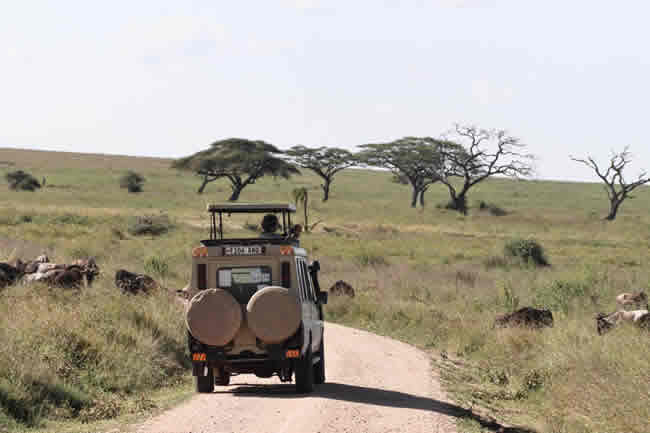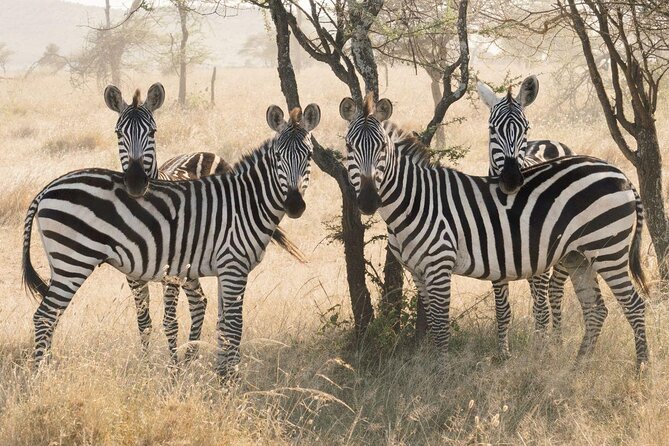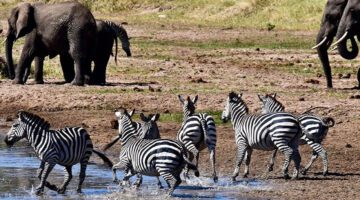...
Serengeti National Park
Serengeti National Park is one of Tanzania’s largest National Park stretching over 14,763 square kilometers in the northern region of the country. It is situated northeast of Simiyu Region in the Mara region covering over 1,500,000 hectares of savannah grassland. Serengeti National Park was named after a Masai phrase “Siringet” meaning “the place that runs on forever”. Serengeti National Park was first gazetted as a game reserve covering an area of 2,286 square kilometers in the eastern and southern Serengeti in 1930.
 It later became a National Park in 1940 after the government of Tanganyika had established a system of National Parks compliant with Convention relative to the preservation of flora and fauna in their natural state. The Masai people were restricted movements within the protected area and Park boundaries finalized in 1951. The government of Tanganyika later catered for the Masai people by cutting off the part of the eastern section of Serengeti to establish the Ngorongoro conservation area that was intended to accommodate their traditional land use interests. Serengeti National Park has gradually expanded from the initial size of 12,950 square kilometers in 1981 to 14,763 square kilometers. Serengeti National Park is known for hosting the largest annual animal migration known as the great wildebeest migration where millions of wildebeests and thousands of other herbivores like gazelles, elands, zebras and many more cross the Mara River to Masai Mara National Reserve in Kenya. This Park also houses Africa’s largest lion population that thrives in the Park’s endless plains.
It later became a National Park in 1940 after the government of Tanganyika had established a system of National Parks compliant with Convention relative to the preservation of flora and fauna in their natural state. The Masai people were restricted movements within the protected area and Park boundaries finalized in 1951. The government of Tanganyika later catered for the Masai people by cutting off the part of the eastern section of Serengeti to establish the Ngorongoro conservation area that was intended to accommodate their traditional land use interests. Serengeti National Park has gradually expanded from the initial size of 12,950 square kilometers in 1981 to 14,763 square kilometers. Serengeti National Park is known for hosting the largest annual animal migration known as the great wildebeest migration where millions of wildebeests and thousands of other herbivores like gazelles, elands, zebras and many more cross the Mara River to Masai Mara National Reserve in Kenya. This Park also houses Africa’s largest lion population that thrives in the Park’s endless plains.
Attractions in Serengeti National Park
Mammals/wildlife
Serengeti National Park is known for housing the largest concentration of large mammals in the entire world. Wildlife is the Park’s major attraction and these include large numbers of lions, large herds of elephants, buffaloes, wildebeests, gazelles, zebras, giraffes, hartebeests, reedbucks, waterbucks, warthogs, bushbucks, rhinoceros, leopards, elands, topis, hippopotamuses, hyenas, cheetahs, impalas, wild dogs, black-backed jackals, banded mongoose, aardwolf, African wildcat, cape hare, ground pangolin, bat eared fox, crested porcupine, African civet, honey badger, African striped weasel, African golden wolf, caracal, serval cats to mention but a few. The Park suitably harbors the above animals in large numbers simply because it has a great diversity of vegetation and habitats that range from savannah grasslands, woodlands, marshes and kopjes to riverine forests.
Bird species
Serengeti National Park is a birding hotspot in Tanzania harboring more than 500 bird species that can be seen all year round. Bird species that are seen in Serengeti National Park include martial eagle, red-billed hornbills, oxpeckers, spur-winged geese, love birds, hamerkops, Egyptian geese, pink-backed pelicans, African fish eagles, shoebills, hadada ibis, abdim’s stork, grey-breasted spur fowl, Masai ostrich, secretary bird, helmeted Guinea fowl, African collared dove, blacksmith lapwing, red-billed buffalo weaver, crowned cranes, southern ground hornbill, saddle-billed stork, sacred ibis, cattle egret, black herons, white stork, yellow-billed stork, goliath heron, knob billed stork, spotted thick knee, marabou stork, lesser flamingos, Kori bustards, vultures to mention but a few.
Great wildebeest migration
The great wildebeest migration is one of the seven natural wonders in the world and the second longest overland animal migration covering a total distance of 800 kilometers. This animal migration starts at the beginning of the dry season where roughly 1.5million wildebeests, gazelles, zebras, common elands and many more start to their long journey northward from Masai Mara National Reserve in Kenya through the Ngorongoro conservation area where half a million of wildebeests are born. By around April and May, large herds of migrating animals pass through the western corridor and cross Rivers such as the Mara River and Grumeti where over 3,000 crocodiles lie in a wait. Other predators that feast on these animals during their movements include lions, hyenas, cheetahs, leopards and many more. Around late October when the dry season ends, large herds of animals start to head back southwards to Masai Mara in Kenya. It is estimated that around 250,000 wildebeests, over 30,000 zebras and gazelles annually lose their lives to predation, exhaustion, drowning, diseases or starving. These large herds of animals journey for these long distances in search for greener pastures and fresh drinking water.
Seronera River Valley
The Seronera River gorge is termed as the highlight of the entire Park since the valley is encompassed with Rivers, gorges, hills and vast populations of animals and bird species. It is at this River Valley where is able to capture perfect and beautiful views of the Serengeti endless plains. Several animals also congregate around this River Valley most especially during the dry season making a perfect place for game viewing.
The Retina Hippo pool
The Retina hippo pool is a haven of large schools of hippopotamuses where they often cool and relax during the entire day before they head off in the evening to graze. This pool attracts several visitors interested in learning more about these creatures such as their social lifestyle and many more.
Olduvai Gorge
The Olduvai Gorge is where an archeologist known as Dr. Louis Leaky discovered the oldest remains of early man about million years ago. This site is significantly situated in Serengeti National Park and annually attracts several visitors that are interested in learning about the evolution of man.
The Moru Kopjes
The Moru Kopjes are protruding rocks that are found within Serengeti National Park and perfect sites for game viewing. Black rhinos are known to thrive around these rocks as well as several predators that are always seen on a wait for their prey as that are attracted by shade whenever the weather conditions are hot.
The Masai people
Serengeti National Park is surrounded by the Masai communities that once lived in this Park before it was gazetted as a National Park. These Masai people still possess their ancient authentic cultural norms and traditions that have barely been touched or modernized. They still carry out their traditional cultural rituals and practices that are worth experiencing during one’s visit to Serengeti National Park.
Grumeti River
This is a perfect spot to experience the wildebeest migration as millions of animals try crossing the River to Masai Mara National Reserve in Kenya. This River is infested with large numbers of predators such as crocodiles that patiently wait to grab animals as they cross the River which is so wondrous. This River attracts several other animals that come to quench their thirst along the River banks.
Activities in Serengeti National Park
Game viewing
The best way to cover Serengeti National Park is by taking on a game drive into the Park’s savannah endless golden plains. This offers the perfect wildlife viewing experience as you look out for the African big gems, big cats, the ugly five and multitudes of several other mammals. The Park offers several game drive experiences throughout the Park’s sections such as the southern section, northern and the central circuit known as the Seronera area. Categories of game drives that Serengeti National Park offers include the morning game drives where visitors are able to catch up with animals in the early morning when they are still active and lively, afternoon or evening game drives that are always conducted after lunch, full day game drives where one spends the entire day covering the Serengeti plains with a bush lunch or picnic under a large fig tree. The other category is the night game drive where one gets a completely unique wildlife experience. Night game drives reveal hidden realms that are seldomly witnessed during the daylight hours such as viewing nocturnal animals active, predators on the hunt and many more.
Birdwatching
Serengeti National Park is a perfect spot for birdwatching in Tanzania since it harbors over 500 bird species across its endless golden plains with most bird species found in the Ndutu area. Birdlife in Serengeti is boosted by its diversified ecosystem that ranges from open savannah grasslands, shrubs, hills and rocky areas to forested regions that are all habitats to different bird species. Birdwatching in Serengeti National Park starts very early in the morning with the guidance of experienced birder guides into their natural habitat while quietly following after them with binoculars and good cameras. The perfect time for birdwatching in Serengeti National Park is in the months of November to April when breeding of bird species is at its peak as well as the perfect period for hosting several migratory bird species.
Hot air balloon safaris
Hot air balloon safaris in Serengeti National Park offer a completely unique experience as one soars across the Park’s endless plains. It is a once in a life time experience to fly above the Park’s vast wildlife while capturing several animals at a relatively high elevation as well as sharing the skies with vast bird species. Hot air balloon safaris start very early in the morning with a briefing from pilots and cabin crew member after which you enter the basket to take up your seats. Magic is experienced as you start feeling the slow motion before it stabilizes for you to stand and start capturing great views of wildlife and fresh air. It lasts for about an hour before you land to enjoy your bush breakfast and champagne celebrations. In Serengeti National Park, hot air balloon safaris are conducted in three sectors namely the northern Serengeti Masai Mara circuit, central Seronera region and the southern Ndutu sector.
Masai cultural tours
The Masai people were the first people to settle in the current Serengeti National before it was gazetted as a protected area in Tanzania. They currently settle in communities close to the Park boundaries and famously known for their nomadic lifestyle. The Masai share with wildlife in the same area with minimal animal and human conflicts. A cultural tour to the Masai communities is one of the untouched cultural trips that one should experience before setting his/her feet off the Serengeti endless plains. A wide range of activities are always available in the Masai communities for visitors to have a touch into their culture such as cultural interactions, experiential grazing, visiting the kraal and milking, learning about their cultural norms, traditions and values, cultural performances in form of music and dances, traditional food preparation, storytelling to mention but a few.
Best time to visit Serengeti National Park
Serengeti National Park can be visited at any time of the year though the best time is during the dry season in the months of December to February and June to September. During this period of the year, the weather is favorable since there are no or less rainfall showers compared to the rainy season when tourist activities are easily interacted. The dry season is also the perfect time for game viewing since temporary water holes dry up forcing animals to congregate around permanent water sources where they can easily be spotted instead of driving deep looking for wildlife. The Great Wildebeest Migration is perfectly witnessed in the period of July to September to enjoy a spectacle of River crossings.
Top Tanzania Destinations
BOOK OUR CURATED SAFARIS
Add Uganda and Rwanda to your travel list this year as we are offering a fantastic tailor-made tours to individual and small groups



